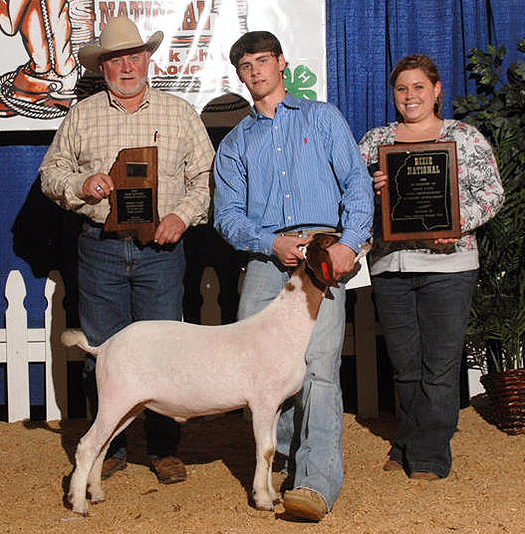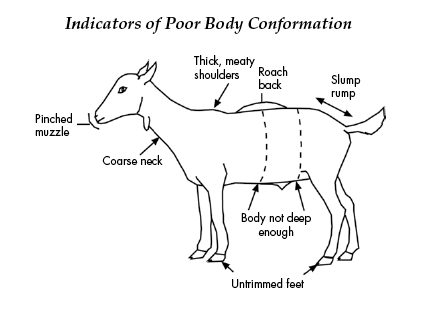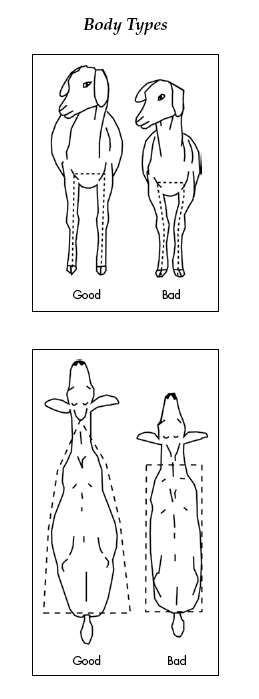4-H Club Goat Guide

Club goat competition in the show arena is becoming more competitive every year as junior exhibitors discover goats are an excellent choice as a livestock project. Goats are relatively small, easy to work with, and only require a small amount of space. They can provide a meaningful and educational livestock experience for a reasonable expense.
Once you decide on a club goat project, you should determine which shows you will attend. It is your responsibility to read the rules and regulations governing the shows you will attend. The rules will determine the number of goats you may enter, weight limits (if any), ownership dates, and entry deadlines. You can get show schedules, rules, and regulations from your county Extension agent or directly from the show.
Show dates are important because they will determine the time of year you should buy your goats and the age of the goats you will purchase. Some shows may require that goats have their milk teeth. Goats usually hold their milk teeth until they are 10 to 12 months of age. Then a goat will probably lose its baby teeth and become ineligible to show. Most shows also have weight limit requirements. Under ideal conditions, goats will usually gain approximately 2 to 3 pounds per week.
Not all goats can be fed to the same final weight because of differences in frame size. Large-frame goats may be correctly finished at 120 pounds, while small-frame goats may be correctly finished at 80 pounds. You must learn to look at indicators of frame size and growth (length of head, neck, cannon bone, and body) to determine at what weight a goat will be correctly finished. If you know the approximate weight of a goat at the time of purchase and the length of time until the show, you can calculate feed requirements (light, moderate, or heavy) needed to let that goat enter the show at its correct weight. A weight calculator is available online. Remember that size does not make a good goat. There are good small goats and good big goats. Your management program is the key.
Facilities and Equipment
One of the major advantages of a club goat project is that you do not need expensive facilities. A barn or shed where goats can get away from cold, wet, or drafty conditions and a pen with outside exposure are essential. Adequate fencing, a feeder, and a clean water container are required. Other equipment is optional.
Barns/sheds
Goats need a shed or barn and an area where they can get outside in the sunshine. Ideally, the shed area will have at least 15 square feet of space for each goat. The outside pen needs to be as large as possible to let the goats exercise. The shed should be well drained and open to the east or south. Barn temperature is critical. Structures should be well ventilated so goats can stay cool and continue to grow in the summer months. However, if club goats are slick shorn for shows, you should change the barns in winter to keep goats as warm as possible. You can do this by closing the front with a tarp or plastic sheet and by using heat lamps.
Fences
The fence should be at least 42 inches high to keep goats from trying to jump. All fences and barns should be predator proof. Net wire fences should be 12-inch mesh rather than 6-inch mesh to keep goats from hanging their heads in the wire. The most desirable pens are made with galvanized livestock panels 5 feet tall with 2-by-2 or 4-by-4-inch squares.
Feeders
Self-feeders are preferred for feeding goats until they reach upper weights. Self-feeders should be at least 6 inches off the ground. When you start to hand-feed goats, use a movable trough that will hang on the fence. Hang troughs at the same height as the top of the shoulder of the goat you are feeding. You should take down these movable troughs and clean them regularly. Hay and mineral feeders also need to be raised off the ground. This will help reduce the spread of disease. It also is important to make sure goats cannot stand in their troughs because they will urinate or defecate on the feed, hay, and minerals.
Water containers
Fresh water is the most important nutrient you can provide for club goats. Water containers should be small enough that you can empty and clean them regularly. Provide clean, fresh water for goats every day. Put containers in the shade to keep water cool. In the hot summer months, some goats may tend to drink too much water and will appear “full.” Water should never be totally removed from the goat. However, rationing water immediately before a show will help remove the “fill” and improve the goat’s appearance in the show ring. Remember, maintaining the proper amount of fluids is vital to the feel and condition of your goat.
Equipment
To feed and exhibit a club goat properly, you should have the following extra equipment:
- stiff brush to clean water troughs
- shovel to clean pens
- trimming table
- small animal grooming clippers
- syringes and needles
- goat blankets and/or socks
- halters, collars, and/or show chains
- hoof trimmers
- small, portable feed troughs
- soft brush for grooming
- water bucket
- extension cords
You may want this equipment if you are exhibiting several goats at major shows:
- show box to hold equipment
- hot air blower or dryer
- portable livestock scales
- muzzles
- electric fans
Selection

Selecting a goat for your project is the most important decision you will make. The type of goat you select will have a major influence on the project’s results. Remember, a winning meat goat is a combination of proper selection, nutritional management, and grooming as well as quality showmanship. Some people have a natural eye for selecting young animals of high caliber. Do not hesitate to ask for help from someone with these skills. It may be your county MSU Extension agent, FFA instructor, parent, or other leader in the county. Many breeders are willing to assist you in your selection.
Muscle and fat are important when selecting a prospect. Young goats with bloom and fat will always look good, while young, thin goats might not look as nice. Learn to look past fat and recognize muscle so you can pick a genetically superior goat. When purchasing a goat, it is important to know something about the producer. Do not hesitate to ask questions about the goat’s bloodline and age.
Consider the following when selecting a goat:
- structural correctness
- muscle
- volume and capacity
- style and balance
- growth potential
Structural correctness
Structural correctness refers to the skeletal system or bone structure of an animal. A goat should hold its head erect, and the neck should extend out the top of the shoulders. A goat should travel and stand wide and straight on both front and rear legs, and the legs should be placed squarely under the body. A goat should have a strong, level top and a long rump with a slight slope from hooks to pins. Your goat should be heavy boned and strong on its pasterns. Avoid goats with open shoulders, weak tops, weak pasterns, or steep rumps.

Muscle
Generally, a goat that walks and stands wide is going to be heavier muscled. The goat should have a deep, heavily muscled leg and rump. When viewed from behind, the widest part of the leg should be the stifle area. The goat should have a broad, thick back and loin that is naturally firm and hard handling. A good goat should be wide through its chest floor, with bold shoulders and a prominent forearm muscle. The forearm is the best indicator of muscling in thin goats.
Volume and capacity
This refers to the relationship of body length to body depth and body width. Goats should be long bodied, with adequate depth and spring of rib. Avoid selecting goats that are short-bodied, shallow-bodied, narrow-based, and flat-ribbed.
Style and balance
Style and balance refer to the way all body parts blend together—how the neck blends into the shoulder, the shoulder into the rib cage, the rib cage into the loin, the loin into the rump—or a smooth flow from nose to tail. This can be referred to as the “eye appeal” of the goat. When viewed from the side, a goat should have a smooth shoulder, level top, trim middle, and straight legs.
Growth potential
An animal’s ability to grow rapidly is very important. Generally, a larger framed goat that shows a long head, neck, cannon bone, and body will grow faster, be larger, and be more competitive in the show ring.
Nutrition
Contrary to popular belief, there is no such thing as a “magic” ration or “magic dust” to add to your ration to make your goat a champion. Implement a good feeding program and analyze the goat to know when to make feed changes. Since goats do not deposit external fat as rapidly as other species of livestock, a self-feeding program is most effective. However, sometimes goats can become too fat during the feeding period and should be hand-fed to control the amount of feed consumed. All livestock require five basic nutrients: water, protein, fats and carbohydrates (or energy), minerals, and vitamins.
Water
Clean, fresh water is a daily necessity, since water composes more than 70 percent of lean tissue, and all body fluids must be replenished regularly. Never deprive your goat of water, because it regulates how much feed a goat will eat. However, reducing water intake immediately before a show can reduce feed intake and reduce the size of the rumen for an improved appearance.
Protein
The main ingredient of the animal body is protein. Dietary protein serves to maintain or replace protein in body tissues, provides for carriers of other nutrients, and is a major part of various products such as meat, milk, and fiber. Protein requirements for goats vary according to their size, age, and maturity. Young, fast-growing goats need more protein to let them grow and develop their full muscle potential. Rations that contain 16 to 18 percent protein are useful during many phases of the feeding program. Remember, goats need protein daily. If you feed more protein than required, the extra is used for energy. Using protein as an energy source is very expensive. When total feed intake is greatly reduced, protein supplementation may be necessary to provide the adequate daily requirements for your goat.
Carbohydrates and fats
The most common limiting nutrients in goat rations are energy-producing carbohydrates and fats. Low energy intake will slow growth and cause weight loss. Enough energy is necessary for efficient nutrient use. Grains and protein supplements are high in energy. In goat rations, too high an energy intake can be just as harmful as too low an energy intake.
Minerals
The most important minerals in goat rations are salt (sodium and chlorine), calcium, and phosphorus. You can feed salt free choice. Calcium and phosphorus are both necessary for proper growth and development. Feed them at a ratio of two parts calcium to one part phosphorus. High levels of phosphorus in relation to calcium can cause urinary calculi. Adding ammonium chloride to a ration will help prevent urinary calculi. Any balanced ration will contain the necessary amounts of minerals to maintain proper growth and development.
Vitamins
Vitamins are essential for proper body function. Goats require them in very small amounts. Only vitamin A is ever likely to be deficient. If you feed goats a small amount of alfalfa hay or dehydrated alfalfa pellets in the ration, then vitamin A deficiency should not be a problem. It is a good practice to occasionally inoculate goats with a B complex vitamin. This promotes their health and helps maintain appetite.
Health
The key to a healthy goat is the development of a preventive health program. Most goats purchased for club projects should be on a health maintenance program and have had a variety of vaccinations. However, as you develop your preventive program, assume the goat you have purchased has had no treatments. You should include in your program vaccinations and treatments for certain common problems.
Enterotoxemia
A major cause of death in club goats is enterotoxemia, or overeating disease. Afflicted animals seldom show symptoms, and rapid death is usually the result. This disease is caused by a clostridial organism normally present in the intestine of most goats. Goats that have their feeding schedules abruptly changed or take in large amounts of grain are subject to enterotoxemia types C and D. Feeding changes can cause the clostridial organism to grow rapidly and produce a powerful toxin that causes death in a few hours. All club goats should be vaccinated with a combination (types C and D) vaccine immediately after purchase. If you did not see the goat vaccinated, do it yourself. At least one booster vaccination is recommended. Once the CD/T vaccine vial has been used, it has a short shelf life. Discarding the vaccine vial after 7-10 days will eliminate any false sense of security on booster vaccinations.
Internal parasites
Internal parasites are a continual problem. Newly purchased goats should be dewormed immediately for internal parasites, and a second treatment should follow about 3 weeks later.
Few dewormers are approved to treat goats for internal parasites. If using cattle dewormers, dosage rates will need to be elevated to 3.5 times the cattle rate for goats. Goats have a higher metabolism rate than cattle, so dosage will have to increase accordingly. Your veterinarian will have the best information on the most effective treatments and authorize any extra-label use. Because internal parasites develop resistance to a dewormer over time, it may be more effective to rotate products at some point.
Urinary calculi
Urinary calculi is a metabolic disease of male goats characterized by the formation of calculi, or stones, in the urinary tract. The first sign of calculi is a goat’s inability to pass urine. The goat will be restless, kick at its belly, stretch, and attempt to urinate. Because grains are high in phosphorus and low in calcium, high-concentrate rations may cause urinary calculi. Use a ration that has a 2:1 CA/P ratio and contains ammonium chloride. Be sure to provide plenty of clean, fresh drinking water at all times.
Coccidiosis
Coccidiosis causes weight loss and continued inefficiency in goats. Bloody diarrhea, dehydration, weight loss, and weakness characterize the disease. Separate sick goats and treat them individually as prescribed by a veterinarian. Most commercial show goat rations are medicated with a coccidiostats that will help control coccidiosis.
Soremouth
Soremouth is a contagious viral disease that causes scabs on the lips and around the goat’s mouth. This virus can affect humans, so be careful when handling goats with soremouth. You can rub iodine into lesions after the scabs are removed, and this will help dry the area and reduce the infection. Vaccines are available to help prevent this problem, but they are not recommended if you do not have the problem in your barn.
Ringworm
Ringworm has been a serious problem in the lamb industry for a number of years. Because most club goats are shown in the same barns and show rings as lambs, ringworm is now a problem in goats, as well. Ringworm can be spread from goat to goat, from goat to human, or from infected equipment to goat. A good prevention program is necessary. Consult your veterinarian for the best information on treatment.
Pinkeye
This contagious disease is characterized by excessive watering of the eye and clouding over of the pupil. Goats are especially susceptible to pinkeye when stressed or after they have been transported to a new location. Dry, dusty pens and constant exposure to sunlight can be contributing factors. Several medications are on the market for pinkeye. If you do not notice improvement within a few days after treatment, contact your veterinarian.
Illegal drugs
State and federal laws and regulations concerning the use of drugs for livestock and poultry help protect human and animal health. They state that instructions and restrictions on product labels must be strictly followed. The labels state which species or class of livestock or poultry the drug is to be used on, the recommended way to give the drug, the approved dosage rate, and specific conditions to be treated. When giving drugs, always follow label instructions.
Using a drug in a manner other than stated on its label is regulated by the Food and Drug Administration and may be done only under the control of a licensed veterinarian. The veterinarian assumes the responsibility for making medical judgments, and you agree to follow the instructions strictly. Most livestock shows have strict policies against the illegal use of drugs and will disqualify animals if such drugs have been used.
Hoof trimming
A goat’s hooves will grow long if they are not naturally worn down by traveling over rough terrain. You should trim long hooves about every 6 weeks. Always trim hooves 1 to 2 weeks before a show in case you accidentally cut into the quick and temporarily cripple the goat. This will allow the goat time to heal before the show. If foot rot develops, trim the hoof closely, treat with an external product, and give an antibiotic.
Dehorning or tipping
Some shows require that goats be dehorned. If you plan to dehorn, it is preferred to “disbud” goats at 10 to 14 days of age. The older the goat is and the larger the horn, the more stressful it will be on the goat. Other shows request only that goat horns be tipped for show. You can easily tip without causing much stress to the goat. You should tip horns 4 to 6 weeks before the show to allow the horns to heal properly. Dehorning or tipping rules are made strictly for the safety of the exhibitors.
Management and Feeding
You have a choice of feeding a commercially prepared ration or mixing your own. Many complete commercial rations are available today. Most “show” rations will contain all the ingredients needed for proper growth and to keep your goat healthy. Since goats are picky eaters, a pelleted ration is recommended over a textured ration. Select a balanced ration; learn how to feed it and how your goat responds.
Many young goats will not know how to eat pelleted feed from a trough. You should start these goats on good, leafy alfalfa hay that is topped with a small amount of feed. After 3 or 4 days, slowly increase the selected ration. Hay is normally fed during the first part of the feeding program, but it should be eliminated in the later stages to prevent goats from developing a large stomach. Most goats can be put on a self-feeder for the entire feeding period. However, some goats may become fat and need to be hand fed.
You must keep check on fat deposition throughout the feeding program. You can adjust the feeding schedule to change gain and body composition, but you must continually keep watch so you can make any more needed changes. Rations not producing enough finish can be bolstered by adding a high-energy ingredient, such as corn, during the late stages of the feeding program. Never make abrupt changes in your feeding program. Make gradual feed changes so your goat will stay on feed and continue to grow and develop. A good program cannot make up for a lack of superior genetics but will let your goat reach its full genetic potential.
Feeding is a daily responsibility. Change your program as needed to get greatest results. Keep check on gain by weighing your goat regularly and recording weights. Exercise can be very good for your goat and for your success in the show ring. Goats are very active animals and, if given enough room, will exercise themselves. Have objects like big rocks or wooden spools in your pen for the goat to climb and jump. This will give your goat an excellent chance to exercise. A goat that exercises will handle harder and firmer and will give you an advantage in the show ring.
Fitting
Some shows may enforce a shearing rule for goats. Since differences in hair length are allowed at shows, it is important to read the show rules before clipping your goat for a particular show. It is necessary to wash your goat before clipping, as clean hair will cut smoother. Use a mild soap sparingly, rinse the animal thoroughly, and dry the goat completely. Regularly brush your goat with a stiff brush because brushing removes dead hair and dirt. Shear your goat according to show rules at least 1 week to 10 days before the show. While shearing, run the clippers parallel to the length of the body rather than vertically. Do not shear hair below the knees and hocks. Bob the hair on the end of the tail. Blend in leg hair with the body, and clip legs to mirror structural correctness. Small animal clippers are preferred to clip closely around the eyes, ears, pasterns, or delicate areas on the goat.
Parts of a Meat Goat

- jaw
- muzzle
- throat
- wattle
- neck
- withers
- crop
- chine
- loin
- back
- hipbone
- rump
- thurl
- tail head
- tail
- pin bone
- thigh
- stifle
- hock
- dew claw
- rear flank
- fore flank
- sheath
- belly
- fore rib
- rear rib
- barrel
- heart girth
- pastern
- hoof
- knee
- chest
Publication 2264 (POD-06-23)
Reviewed by Dean Jousan, PhD, Associate Extension Professor, Animal and Dairy Sciences. Written by R. Kipp Brown, Extension Livestock Coordinator (retired), Animal and Dairy Sciences. Adapted from Publication AS 3-4.059, Texas Agricultural Extension Service.
The Mississippi State University Extension Service is working to ensure all web content is accessible to all users. If you need assistance accessing any of our content, please email the webteam or call 662-325-2262.





